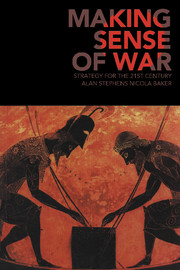Book contents
- Frontmatter
- Contents
- Abbreviations
- Preface
- Introduction
- Chapter 1 How to win
- Chapter 2 Stove-piped strategy
- Chapter 3 Traditional warfighting concepts and practices
- Chapter 4 Manoeuvre and the application of force
- Chapter 5 Shaping the strategic environment
- Chapter 6 Strategic paralysis
- Chapter 7 Contemplating war
- Chapter 8 Constraints on war
- Chapter 9 Controlling war
- Chapter 10 Peacemaking
- Chapter 11 War in the twenty-first century
- Notes
- Select bibliography
- Index
Chapter 3 - Traditional warfighting concepts and practices
What strategy has been
Published online by Cambridge University Press: 05 June 2012
- Frontmatter
- Contents
- Abbreviations
- Preface
- Introduction
- Chapter 1 How to win
- Chapter 2 Stove-piped strategy
- Chapter 3 Traditional warfighting concepts and practices
- Chapter 4 Manoeuvre and the application of force
- Chapter 5 Shaping the strategic environment
- Chapter 6 Strategic paralysis
- Chapter 7 Contemplating war
- Chapter 8 Constraints on war
- Chapter 9 Controlling war
- Chapter 10 Peacemaking
- Chapter 11 War in the twenty-first century
- Notes
- Select bibliography
- Index
Summary
THE DISTINGUISHED MILITARY HISTORIAN Sir Michael Howard once pointed out that ‘theory must constantly pass the test of reality’. Howard's wise caution applies equally to strategy. A strategy that has not been applied and tested in conflict might be regarded as theoretical, as unproven against the benchmark of operations. This chapter is concerned with applying the test of reality, with measuring theory against practice, and it will do so by examining the ways in which military forces traditionally have tried to win – that is, by examining what strategy has been.
Reduced to its basics, warfighting comprises two elements: a test of strength, and a clash of wills. The ultimate objective of any military confrontation, regardless of its scale, is to break the enemy's will to fight: to achieve a measure of dominance over his thinking such that he concludes the costs of continued resistance will exceed those of submission; or that he simply loses the spirit to resist. Ideally this outcome would be attained without a shot being fired, through the psychology of coercion, an approach which can take many forms, including physical intimidation, economic measures, diplomatic pressure, and adverse publicity. Countless prospective blood-letting has been prevented by the dynamics of deterrence.
However, because we do not live in an ideal world, psychological coercion might not always be an acceptable option for one or both protagonists. Or, for reasons that sometimes seem impenetrable to others, one side might be determined to pursue military action, regardless of the circumstances.
- Type
- Chapter
- Information
- Making Sense of WarStrategy for the 21st Century, pp. 34 - 68Publisher: Cambridge University PressPrint publication year: 2006

